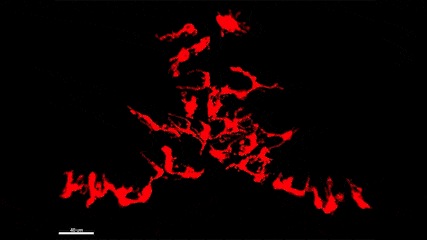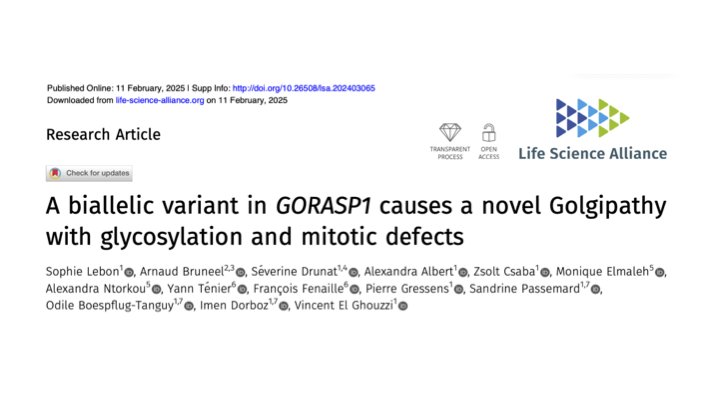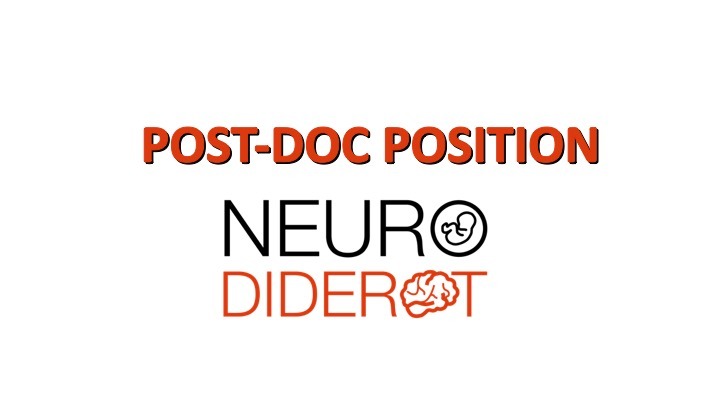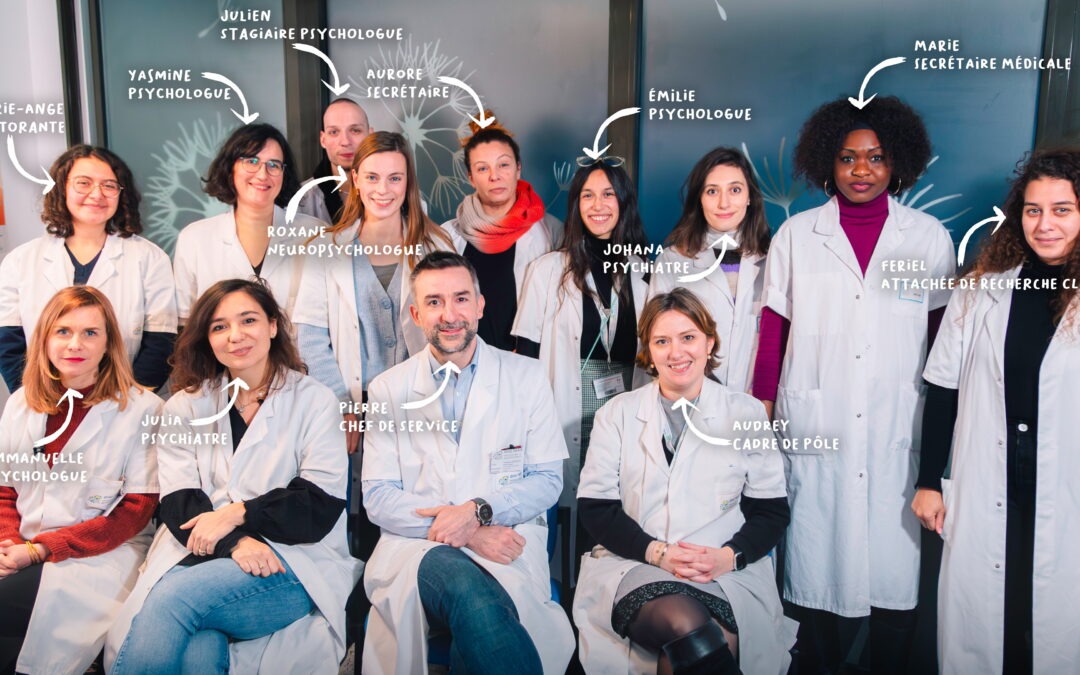Microglia and epilepsy in the zebrafish
Group Nadia Soussi-Yanicostas

Epilepsy is one of the most frequent neurological disorder affecting more than 65 million people worldwide. Moreover, while many antiepileptic drugs (AEDs) are available today, a third of patients resist these treatments, making the discovery of new therapeutic targets and new AEDs, an urgent need and a major public health issue. In particular, although it has been known for more than 20 years that epileptic seizures cause massive neuroinflammation of the brain, which is caused by the activation of microglia, the brain’s resident marcrophages, the therapeutic possibilities offered by these cells have been little studied to date. More generally, the role of these cells in the pathophysiology of epilepsy and the consequences of their activation in the short, medium and long term remain poorly understood. In this context, Nadia Soussi-Yanicostas’s group uses the zebrafish as a model to better understand the role of microglia in epilepsy. The interest of the zebrafish as an epilepsy model is emphasized by recent therapeutic screens, which were performed using epileptic zebrafish larvae and led to the discovery of novel AEDs, including clemizole, which is now tested in human epileptic patients. In our team, we take advantage of the transparency of the zebrafish embryo to study the response of microglia to seizures in vivo in the brain of several epilepsy mutants (such as the scn1Lab, garbrg2, gabra1, and depdc5 genes causing Dravet syndrome in human), using real time imaging of microglia combined with neuronal calcium imaging, qRT-PCR, microglia ablation, and behavior analysis. We also studied the response of microglial cells following intoxication of the central nervous system by organophosphate pesticide.
Our work indicates that pharmacological manipulation of microglial response provides a new novel and promising approach to reduce the devastating impact of microglia neuroinflammation on brain neurons, either in the case of neurodevelopmental diseases (such as childhood epileptic encephalopathy) or that of exposure to environnemental neurotoxicants (such as organophosphates).
Recent works
We demonstrated that there is a shift of the synaptic balance in favor of excitation in the brains of three different zebrafish mutants that exhibit epileptiform seizures; scn1Lab (Brenet A. et al. Cells 2019), gabra1 (Samarut E. et al. Epilepsia 2018) and depdc5 (Swaminathan A. et al. Curr. Biol. 2018). During our work on the scn1Lab mutant, we also showed the perfect correlation between electroencephalographic recordings of brain activity and in vivo calcium imaging (Brenet A. et al. Cells 2019).
Using an in vivo model of neuroinflammation in zebrafish embryo, we first showed that carbetocin, an oxytocin analogue, has strong anti-inflammatory effects via its action on microglia (Mairesse J. et al. Glia 2019). More recently, we have shown that this oxytocin analog reduces the number and intensity of seizures in scn1Lab embryos via its anti-inflammatory action on microglia (Brenet A. et al. In prep).
We have developed the first zebrafish model of poisoning with DFP, an organophosphate close to the nerve gas sarin. We thus confirmed the neurotoxicity of this compound as well as its epileptogenic effects (Brenet A. et al. Sci. Rep. 2020), which induce massive neuroinflammation of microglia (Maupu C. et al. Neurobiol. Dis. 2021; Somkhit J. et al. Int. J. Mol. Sci. 2022). We are currently testing new molecules protecting against organophosphate poisoning.
We have shown that bixafen, a succinate dehydrogenase inhibitor (SDHi) family fungicide widely used by farmers, exhibits developmental neurotoxicity for the zebrafish embryo at environmentally relevant doses. This toxicity results in microcephaly and disorganization of motor axons (Brenet A. et al. Chemosphere 2021). These results were the subject of a press release in the CNRS journal (CNRS, News 11/6/2020) and an article in the daily Le Monde on 11/21/2020. Finally, this work and the dangers represented by SDHis, the toxicity of which remains little studied, led us to review all toxicology studies of SDHis carried out to date in zebrafish (Yanicostas C. and Soussi-Yanicostas N. Int J. Mol. Sci. 2021). In line with this work, we are currently studying the transgenerational effects of these pesticides and the epigenetic modifications involved.
More recently, we showed for the first time in vivo that epileptiform seizures in the scn1Lab mutant induce neuroinflammation of microglial origin, but above all, that in the absence of microglia, the seizures are more intense and more frequent, indicating that despite the neuroinflammation they induce, microglia have a neuroprotective role (Brenet A. et al. In prep. hal-03745018v2). We are currently investigating the response of microglia to epileptiform seizures using the gabrg2 mutant in which seizures are light-inducible, making it possible to monitor in vivo the dynamics of the response of these cells to seizures.
At the technological level, we have developed a simple and inexpensive method that allows real-time measurement of O2 consumption in living zebrafish embryos (Somkhit J. et al. Zebrafish 2020).

Video showing phagocytosis of apoptotic cells by microglia in real time in the brain of a 4-day-old zebrafish embryo.
Microglia (red) catches dead cells (yellow) by its extensions and then digests them to cleanse the brain (Nadia Soussi-Yanicostas’team).
Contacts
Nadia Soussi-Yanicostas
NeuroDiderot, Inserm U1141
Hôpital Robert Debré
48 boulevard Sérurier
75019 Paris
nadia.soussi@inserm.fr
À lire aussi

New Golgipathy identified in NeuroDev team
The NeuroDev team publishes an article in Life Science Alliance [1] identifying the first human pathogenic variant of GORASP1, the gene encoding the Golgi stacking protein GRASP65, and demonstrating its consequences on glycosylation and mitotic progression. [1] S....

Post-doc opportunity (1-2 years) within the group “Mitochondria and NDD” in the NeuroDev team
POSITION DESCRIPTION Postdoctoral position in the field of Neurosciences Type of contract: temporary position (CDD) Contract/project period: 1-2 years Expected date of employment: 1.04.2025 Proportion of work: 100% Workplace: Université Paris Cité, Inserm,...

Advancing psychiatry through Sleep and Chronobiology research
The “Mood” research axis of the SleepCmd team is dedicated to understanding the intricate links between sleep, circadian rhythms, and mood disorders such as depression, bipolar disorder, seasonal affective disorder, and suicide. Using state-of-the-art methods, the...

Job opportunity within The Integrative Genomics in Neurodevelopment group
The Integrative Genomics in Neurodevelopment group is seeking a highly motivated post-doctoral researcher. Check out the opportunity here: Post-doc researcher position in Computational Biology
